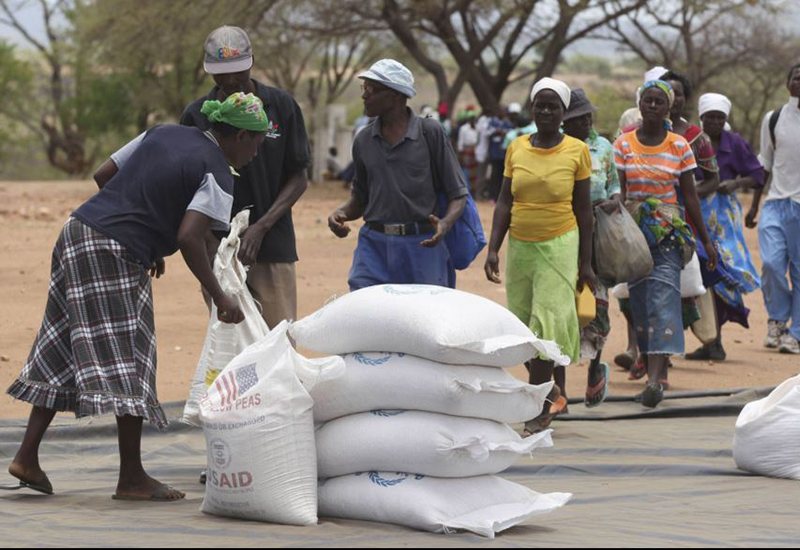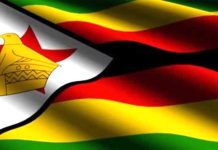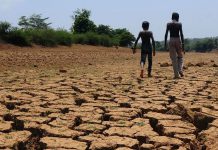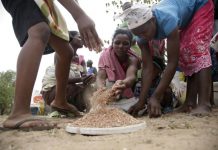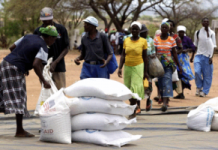People lined up early to have the opportunity to buy subsidized cornmeal from the government-managed Grain Marketing Board deposit at Harare, at prices they could afford. After three hours, a guard appeared to announce that the supply of the deposit was rotten, so there would be none for sale that day.
The crowd of 150 reacted with disbelief and anger.
“Life is hard, all things are expensive, there are no price controls and inflation continues to get worse,” said Benjamini Dunha, 57, a plumber who earns 700 Zimbabwean dollars a month, about $ 38 at rates of official change. Less than a year ago, his salary was worth much closer to $ 700.
Another buyer, Nyasha Domboka, 52, spoke cynically about a truck full of cornmeal, also known as flour flour, which he had just seen in the warehouse parking lot. “How can you say that recently packed meals have suddenly spoiled?” He asked.
A combination of government dysfunction, an economic collapse, droughts and A calamitous cyclone last March led Zimbabwe to a hunger disaster that has become the most serious in southern Africa and one of the most alarming in the world. While food is still not necessarily scarce, it is becoming inaccessible to everyone, except for the privileged few.
“I cannot emphasize enough the urgency of the situation in Zimbabwe,” Hilal Elver, a United Nations independent human rights expert in food security, He said after a 10-day visit in November. 60 percent of the country’s 14 million people, Elver said, are “food insecure and live in a home that can’t get enough food to meet basic needs.”
Hunger in Africa is a widespread problem, but in Zimbabwe, once known as the mainland’s barn, it has been aggravated by the dysfunction that has left the country in its most severe economic crisis in a decade. The annual inflation rate, which the International Monetary Fund has rated as the highest in the world, is 300 percent.
Cornmeal, a staple of the Zimbabwean diet, doubled its price in November to 101 Zimbabwean dollars per sack of 10 kilograms. Now it costs 117. In early December, a two-liter bottle of cooking oil cost 59 Zimbabwean dollars. Now it costs more than 72.
“The money here is worthless now,” said Dunha, who has eight children. All they can afford to eat, he said, are vegetables and sadza, a thick porridge of boiled cornmeal.
Gerald Bourke, spokesman for the operations of the World Food Program in South Africa, the United Nations anti-hunger agency, said that until recently, 60 percent of its assistance to Zimbabweans was in cash, but that Recipients no I don’t want the money anymore.
“Inflation is a rampant problem and people said,” we would prefer food, “said Bourke.
Then, in January, he said, the agency intends to switch to a “completely in-kind food programme” for the first time in Zimbabwe, distributing monthly rations of grains, oil and nutritional supplements for children under 5. The agency will also double the number of recipients to four million.
“This is certainly the worst we are seeing in South Africa,” Bourke said during a field visit in mid-December to Harare, the capital. While cases of acute hunger have not been uncommon in rural areas of Zimbabwe, “it is now seen in cities,” he said. “Hungry people in the countryside move to the cities” in search of food.
The finance minister, Mthuli Ncube, He said Friday that the government would spend 180 million Zimbabwe dollars a month in subsidies as part of an effort to keep the price of cornmeal stable.
But for many Zimbabweans, there is a fear that the inflation problem would presage a return to the days of more than a decade ago, when a trip to buy groceries required cash trolleys. Even now, shopping for anything beyond cornmeal is considered a luxury.
“We used to buy favorite foods like ice cream, cheese, bacon, sausages and ham and prepare good breakfasts for our families,” said Moreblessing Nyambara, a 35-year-old Harare school teacher. “These things are a vision of the past now.”
Many historians attribute Zimbabwe’s plight to the legacy of Robert Mugabe, the father of independence in 1980. An icon of African anti-colonialism, Mugabe became a despot and presided over the decline of what had been one of the most prosperous lands in Africa. He was expelled in 2017 and died in September at age 95.
Any hope that Mugabe’s former ally and successor, Emmerson Mnangagwa, could revive Zimbabwe’s economy has almost completely vanished.
Last June, Mr. Mnangagwa rejected a policy known as dollarization, in which the United States dollar and other foreign currencies were used as legal tender. That policy had been introduced in 2009 and helped end an era of hyperinflation, which had made the Zimbabwean dollar literally less valuable than the paper it was printed on.
But a newly introduced version of the Zimbabwean dollar has fallen in value, drastically increasing the prices of goods that are quoted in the currency.
Foreigners are reluctant to invest in Zimbabwe despite Mr. Mnangagwa’s proclamation that the country is “open to business.” Export sales and remittances from the Zimbabwean diaspora, important sources of US dollars needed to import food and fuel, have declined.
Mr. Mnangagwa has rejected calls to restore dollarization.
“No progressive nation can progress without its own currency”. He told the members of the ruling ZANU-PF party at his annual conference in mid-December. “We will not return.”
Even so, for now, the problem of inflation remains less severe than the one that prevailed over a decade ago.
At that time, prices doubled every day, reaching a point where a single sheet of two-layer toilet paper cost almost as much as a 500-dollar bill from Zimbabwe, then the smallest in circulation. That comparison generated somber jokes about a better use of currency.
Four million Zimbabweans are now not so far from famine, according to A scale commonly used internationally to classify the severity of food insecurity and malnutrition. In the five phases of the scale, Phase 1 is minimal and Phase 5 is hunger.
Bourke, the show’s spokesman, said that the most hungry Zimbabweans are now in Phase 3 or Phase 4.
With Zimbabwe’s last corn crop halved compared to the previous year due to drought, he said, aid will continue until at least until the end of April, when the next harvest is expected. But he was not optimistic.
“Meteorologists basically say that we are seeing a very dry growing season,” said Bourke.
Ursula Mueller, Deputy Emergency Assistance Coordinator at the United Nations, who visited Zimbabwe in June, said the country’s difficulties were partly related to a broader climate crisis in South Africa that has spread across all facets of life.
Drought breeds less food, which in turn leads to declines in health and education and increases in crime and other “negative coping mechanisms,” he said.
“This is not just a food crisis, it is a broader and more complicated situation,” he said in a telephone interview on Friday. “People have to make decisions: do I seek H.I.V. treatment or food?
Ms. Mueller also said that a United Nations humanitarian budget for Zimbabwe had received only half of almost $ 468 million requested, which forced his office to resort to other emergency funds. The humanitarian aid of the United Nations is financed almost entirely by voluntary contributions.
Beyond immediate assistance, Mueller said, more investments were needed to address the root causes of problems in Zimbabwe and other countries that have the potential for greater self-reliance.
“We need to get out of this cycle of dependency,” he said. Otherwise, “humanitarian workers are in prolonged situations for years.”

